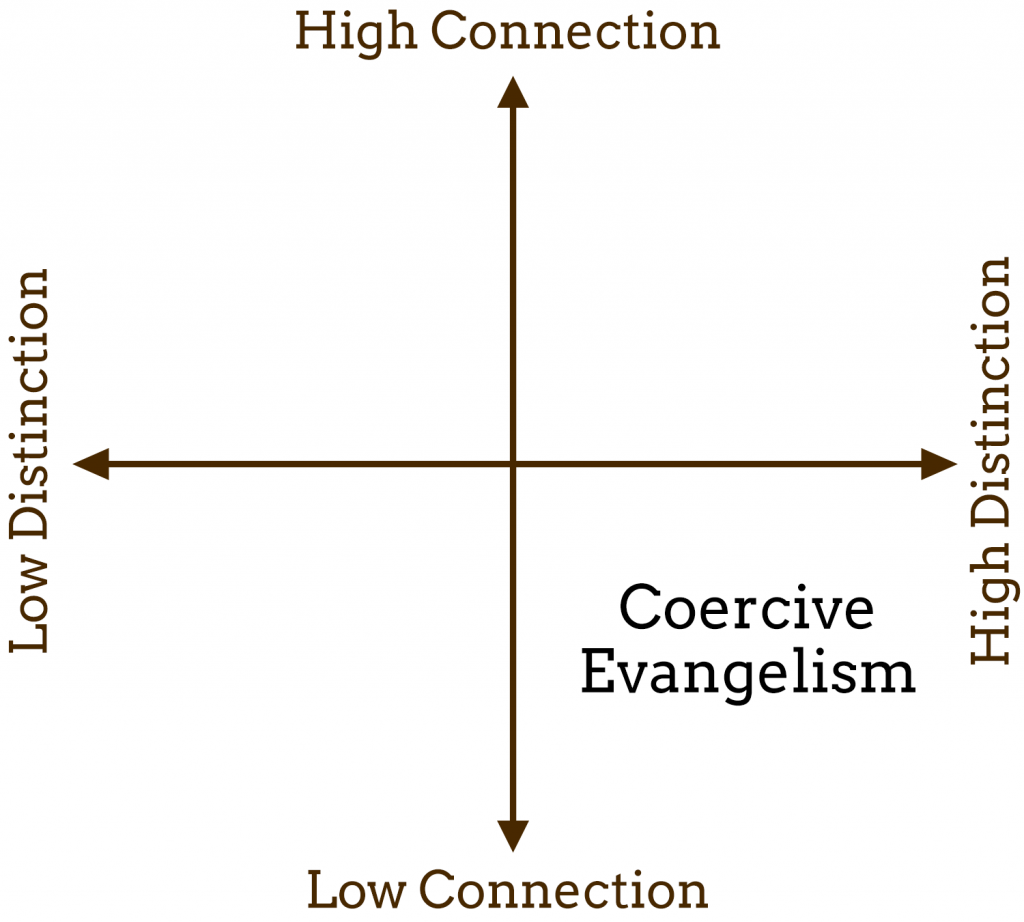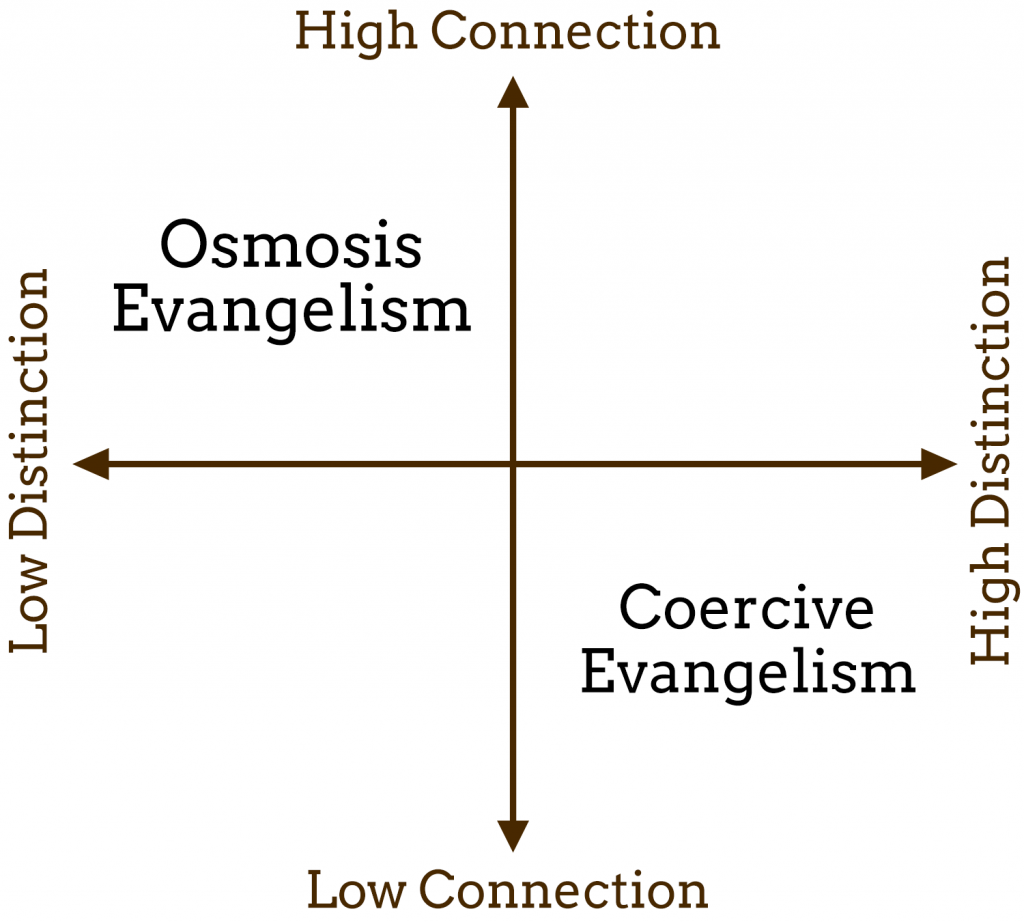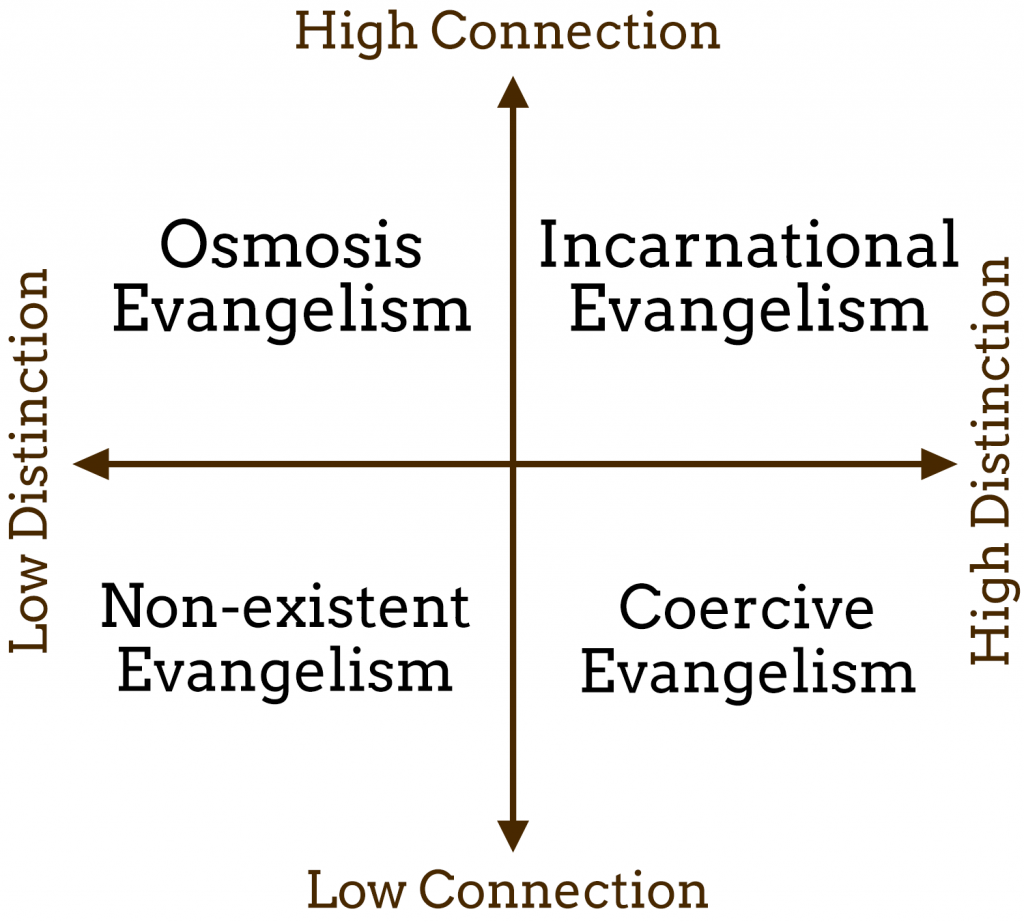2 Ways Most Christians Fail at Evangelism
One of the most difficult aspects of Christianity for me to embrace and practice has been the whole evangelism thing. I’ve just never been comfortable with it.
And as I talk with pastors and Christian leaders around the country (especially younger ones), I hear the same story. Evangelism just doesn’t feel natural to a lot of us.
It’s like evangelism is the awkward guy at the party who can’t follow the conversation and always talks a little too loudly. It’s fine, he’s nice enough, but you just don’t know how to relate to him.
So what’s the deal with that? Are we “ashamed of the gospel” and need to get over ourselves? Are we trying too hard to be “relevant” or something?
Maybe, but I think something deeper is going on here.

Evangelism as winning arguments?
Here’s what I mean. My hesitations with evangelism stem from seeing it done badly.
Many evangelism techniques from a generation ago seem to be focused on how to confront strangers with the “truth,” win an argument, and thus win them to Jesus.
After all, if you were serious about your faith, if you really loved Jesus, you’d care enough about people’s ultimate destiny to give them an opportunity to get saved, right?
- “Excuse me, ma’am, if you died tonight, do you know without a shadow of a doubt that you’d go to heaven?”
- “If God doesn’t exist, then why is there anything?”
Then you were equipped to answer their objections, “proving” that the Bible was true! Because of your ability to intellectually destroy them, they’d be forced into falling on their knees and confessing that Jesus is Lord.
If you were smart and relentless and committed enough, you could argue people straight into the kingdom, saving their souls!
But I wasn’t buying it. To me, this kind of thing looked like ethically questionable bait-and-switch tactics, coercive conversation outlines, and hard sell techniques filled with fear, guilt, and shame. Nothing I wanted to be involved in.
Plus, (spoiler alert), it doesn’t work! Even if they “get in” because of the fear, guilt, and shame, they’re not actually getting saved from anything. They’re just signing up for more bondage! Yuck!
Embarrassed by coercive evangelism
I have to confess an intense double embarrassment regarding these kinds of evangelistic strategies. On the one hand, I was embarrassed to use these techniques on others, and also felt embarrassed when others occasionally used them on me.
One time when I was walking through an airport someone handed me a tract and asked me if I knew if I was going to heaven.
I sort of answered awkwardly that I was already a Christian, but that wasn’t part of his conversation script, so he kept trying to bring me back to how I knew I was going to heaven…
Ugh! At that point I just felt slimed and walked past him.
Isn’t that interesting? I was “on his team,” so to speak, but I felt like a pawn in his game. There was nothing authentic about the conversation. He wasn’t interested in me, just interested in getting another notch in his evangelism belt.
I just didn’t have the stomach to do that to people. It didn’t feel right. It wasn’t effective, but I assumed my attitude was the problem, and I was ashamed that I wasn’t more passionate about “sharing my faith.”
Evangelism by osmosis?
I responded to these confrontational evangelism techniques in the way that many others do—I backed off and simply tried to connect with people outside the church. I tried to get to know them as people, not prospects.
Which felt like such a relief! I figured this was how people would get to know Jesus and come to faith, through simple friendships where we were connected in our similarities.
I was practicing a kind of “sneaky evangelism” where I hoped that by being loose acquaintances with people, they would eventually just sort of become Christians by osmosis.
But even though it felt better, it seemed to bear about as much fruit as the coercive method (almost none).
As I’d get to know people, they’d find out I was a Christian, but that didn’t seem to mean much.
They’d talk vaguely about going to church as a kid, or even how they go to church occasionally now. Me being a Christian was basically just an interesting fact about me. Like someone with a nose ring or a passion for ballroom dancing or a Haitian ancestry.
My faith was a curiosity at best. It didn’t explain anything remarkable about me. It was just an interesting religious preference, like some people enjoy meditation and others go to church. To each their own.
Connection and distinction
So if coercive evangelism doesn’t work, and neither does “osmosis evangelism,” where does that leave us?
Here’s the thing: whenever you find yourself having only two unsatisfying options, there’s probably another dimension to the problem you’re not thinking about.
So instead of thinking about these 2 ways we all fail at evangelism as opposite ends of a spectrum, think about them as emphasizing two necessary elements in an evangelism strategy that works.
We need connection to the people we are trying to reach, as well as distinction from them. Like this:

Coercive evangelism fail
Remember the first way we fail at evangelism? We try to manipulate and coerce people into the kingdom. We accost random strangers and ask them about their eternal destiny and try to win an argument.
These kinds of evangelism techniques are what we might call high-distinction tactics. Right out of the gate, I emphasize how I am different from you, and how you can become like me.
Of course the problem with this approach is that nobody cares! They can see you’re different, but the way you’re different is that you’re an insensitive busybody who doesn’t actually care about me.
It doesn’t matter how good your argument is! You have no relational connection with the person you’re speaking with, so they don’t really care. This is coercive evangelism: high-distinction, but low connection.

Osmosis evangelism fail
But of course the other way most of us fail at evangelism is when we swing to the other extreme: high connection, but low distinction.
This is when we turn down the distinction and turn up the connection. We simply become “friends” with people, hoping they’ll become Christians by osmosis. At the end of the day, you can’t call anyone to anything, because there’s nothing really distinct about you.
“Come join us, because we’re exactly like you!” is not a compelling vision, nor does it even make sense! You can’t join something if you already belong. If I’m no different than you there’s nowhere for you to move. This is why osmosis evangelism doesn’t work.

Incarnational evangelism
This is the false dichotomy we get stuck in…
- Without distinction, there’s nothing to call people to, but without connection, there’s no people to call!
- Without connection, no one will listen. Without distinction, you have no message.
- Without connection, your distinction looks suspiciously like a colonization program. Without distinction, your connection doesn’t lead anywhere.
So what’s the third way? What’s evangelism with high connection and high distinction? What the upper-right quadrant? It’s incarnational evangelism.

This is evangelism in the way of Jesus, because Jesus, as the incarnation, is the perfect embodiment of connection AND distinction at the same time. Jesus is 100% human (connection), and 100% God (distinction).
He embodies connection by fully identifying with us in becoming human. He also embodies distinction from us in remaining fully divine and calling us toward divine life.
One of the most remarkable things about Jesus’ ministry was that “sinners” wanted to be with him, even though he was so clearly not like them.
Jesus reached out to connect with people, and he called them into the thing that was distinct about him: life in the kingdom of God.
How about you?
Now, there’s a lot more to say about how we are distinct and how we connect (seriously! So much to say!), but maybe the paradigm shift is enough for now.
(Plus, learning to actually practice things like incarnational evangelism take time, training, and relationship, which is why we take 10 months to do this kind of thing in our coaching cohorts!)
We’d love to hear from you. Does this resonate? What observations or reflections do you have? Does it bring up any questions for you? Leave a comment below to join the conversation!
This work by Gravity Commons is licensed under CC BY-NC-ND 4.0
Free Spiritual Formation Exercise
Learn how to reckon with desire in your faith journey (something that's kind of scary for most of us).
Just want to stay in touch?
Join our mailing list
24 Comments
Leave a Comment
Join the Gravity Community
A space for people who want to find their way into a more generous, joyful, decolonized Christian faith together.

Ugh! Fantastic post, Ben. You offer clear language here for a debilitating struggle. One I still have not overcome, which, when I’m honest, is shame-inducing.
If I allow myself to keep running in the mental trajectory your post carries me, the ways Jesus distinguished himself come to mind (which is also the way he modeled what healthy distinguishing looks like). That is living a life, fully as the beloved of God and, therefore, increasingly surrendered to His ways. Ways of compassion, which include a character dimension (fruit of the Spirit) and a power dimension (gifts/power of the Spirit). [And for my Calvinist friends, yes, there is a difference between Jesus’s process and our process–he was without the stain of sin, we aren’t, and so our process is often sluggish.]
What I’d say is that one potential wormhole in the process of building High Connection is when the *quality* of High Distinction is greater. That is, the greater the quality of distinction, the faster the potential of connection is made. In context with your piece, the “coorecive evangelist’s” distinction may be considered to be in the negative quality; experienced as morally defunct/negatively distinguished.
But the relational/compassionate “power evangelist” who lives a lifestyle of [attempted] perpetual prayer, increasingly desires/recognizes/acts upon the Spirit’s input, gently communicates a (hopefully) prophetic phrase she “heard” to her new acquaintance, Turns out the insight is right on, bringing hope and healing. In this case, High Distinction *and* High Connection result.
A few bible examples come to mind:
[Jesus To Nathaniel]: “I saw you under the fig tree.”
[Jesus To the woman at the well]: “You are right when you say you have no husband…you have had five husbands, and the man you now have is not your husband.”
[An angel to Philip]: “Now an angel of the Lord said to Philip, “Rise and go toward the south to the road that goes down from Jerusalem to Gaza.” This is a desert place. And he rose and went. And there was an Ethiopian, a eunuch.”
Thus the “coorecive evangelist” is a -3 on the Distinction axis, Jesus, Philip and the prophetic soccer mom are a +5s. Their *quality* of distinction was led to an almost-instant High Connection. All of these characterize a primary way, if not *the* primary way of evangelism of Jesus. And, potentially, us.
I’m thinking out loud here. My main pressure-point is, if what I am saying is true (and I know some who’d say it’s malarkey), how do we collectively and sustainably grow in our expression of High-Quality (Spirit-empowered)-High-Distinction, which enables High-Connection-evangelism? A commitment to doing it poorly, comes to mind 🙂
Again, thanks for stimulating this thought and prayer, Ben.
Great thoughts, John! You’re exactly right that we need a certain *kind* of distinction for the connection to work. In some ways I think the right kind of distinction is what happens when we grow as (Spirit-empowered) disciples of Jesus. A true process of discipleship will essentially be a call to live a life of prayer, love, and service to others. I’m struck by Jesus’ prophetic words to those he reaches out to, but also struck by his heart to serve them: “What do you want me to do for you?”
I think I also see in my own life that as God has worked in my life, growing me more fully into love and power, that connecting with others “feels” easier. Maybe because I’m better able to demonstrate and articulate the realities that my proclamation points to? Also better able to recognize where God is at work in other people’s lives?
That is really true! I love the clarity of it.
There is nothing like the real thing! People know and sense it and are looking for it!
Very much liked the article as well as the matrix diagram. I would suggest their may be a better word than incarnation. If I show this to someone who may not have a biblical vocabulary that word may be foreign. Would a word like “integrated” fit better for those that are on the “outside”?
Not a great post: here’s why. I was with you all the way to the end. I was like, this is awesome! I can preach/teach this in my church to our people because most fall into the two categories. Some don’t know why they are failing. This will help them! But no. Incarnational relationship. Jesus was different from them but people were attracted to him. Really? That’s what I bring to my people as the answer? Not good enough. Go back and find an answer that actually helps my people break the awkward relational problems of our equally isolated and disturbingly lonely culture, and try again. My people get this. They know Jesus was incarnational. They know they are called to be like him. But there is no vehicle for social interaction in our culture apart from sporting events, food and social media. So how do we overcome this? People were attracted to Jesus. Go do likewise. Ok. How? Back to the quadrant with you!
Well said. When my hubby and I turned back to Jesus from 10 years of doing life on our own, we had missed several of the “evangelism programs” alluded to here. Well, maybe they had been used on us and we missed it! Anyway…because balance is that thing you pass as you swing from one extreme to the other…”friendship evangelism” was bound to happen.
Now we are trying to help people understand incarnational ministry as we are learning it ourselves. The tricky part is to allow the messy. Jesus didn’t always do everything the same way and neither should we. Walking with Him and making mistakes and trying again…not being critical of others who are in this same process…whew. It’s a messy journey but so worth it.
Thanks for your voice.
Hi Joe, thanks for taking the time to comment. I hear your frustration and I get it! The problem is that a blog post can’t do what you’re wanting it to do. The post was intended to provoke some new awareness and start a paradigm shift. But *how* to actually live into incarnational evangelism is a HUGE process that can’t be accomplished by simply giving more information. This is why we take 12 months to train people in these kinds of things in our coaching cohorts! It takes time, and it takes training, and it takes relationship. I wish we could just deliver the solutions by giving information, but that’s just not how we learn and grow. Again, I appreciate your interaction with the post!
Hey Derek- I get what you’re saying. This article was written to provoke a paradigm shift for leaders, so how it works out on the ground may need to change, depending on context, etc. I also wanted to point to the fact that Jesus is our model for this. That being said, though, I do like the word “Integrated”! Fits really well what I’m talking about in that quadrant.
Mariann, this is a great comment! “Allowing for the messy” and not doing things the same way every time (discerning the context, discerning what God is doing), are hugely important parts of the way we train leaders. You’re definitely on the right track, it seems! Thanks for taking the time to write.
Really appreciate this post Ben! Particularly helpful for me as a college student right now.
Glad to hear it Emily! Blessings on your freshman year!
This was a very helpful blog post, Ben. Thank you! I think a lot of believers know that they don’t want to do coercive evangelism (because they’ve tried it and couldn’t stomach it or been on the receiving end and found it offputting) but they’re not sure what the alternative is. Yet like you they’ve also discovered that osmosis evangelism doesn’t seem to work either. I think this causes a lot of believers to just opt out of evangelism altogether, even though they care deeply about it.
Thank you for this post. I would love to see a follow-up post with some practical examples of how incarnational evangelism actually works – perhaps with examples from your own life and/or Jesus’ ministry? That would be ever so helpful! Thanks again, Ben. 🙂
Hi Kim, thanks for your question and idea on a follow-up post. It’s exactly the right question to wonder how it actually works, and we do have a few resources on this kind of question (this one, for example). But I’ll also say that your question gets at precisely what our entire project is about at Gravity Leadership. Learning to inhabit spaces/relationships in this incarnational way is what we do for our entire first year of coaching, for example. (plus we believe when you start doing evangelism this way, you discover it’s precisely how Jesus also did discipleship, thus discovering that evangelism and discipleship are basically the same thing ;). So it’s the right question, and it looks LOTS of different ways (Jesus with the woman at the well, or with Zaccheus, or the rich young ruler, or with his own disciples…), and you discern what you specifically need to learn by processing what you’re noticing as you engage (and fail!). That’s the whole process that we’ve been experimenting with and creating training for for several years now, and unfortunately, we’ve discovered you can’t learn it just by reading about it. But it IS precisely the right question!
On Evangelizing 1. we are dealing with two great human fears; rejection and change. We shun exposing our love of Christ and wanting to share it because of what I call the Moses’ excuses. Not smart enough, don’t speak well, I’ll be rejected and I won’t know what to do. On the other hand people fear change and most importantly don’t want their comfort zone disrupted. Not now, I’m too busy, you can’t understand my life, God, are you serious! Reaching out involves risk, and building a relationship which means overcoming your own fears and becoming like Christ and having a conversation. On the other side we need to recognize that change only occurs when the pain of making a change is less than the pain they are suffering. Causing more pain doesn’t bring people closer to you and Christ. Only a firm sincere friendship, a deep personal introspection into you own relationship with a loving God and falling in love with Him works. They will know you are different and your caring will show. Most people don’t respond because they do not want to change, only God and through us can allow them to see the joy we share with HIM and give them a glimpse of what can exist for them with HIM. Change will occur!
Amazing how versatile the grace and truth matrix is!
Here is a story of a modern evangelist that happened today. I am working with a tattoo artist, with intricate symbols and drawings all over his body, even his face, and every inch of his torso and arms. There are many images of death and even demons. I tell him he is uniquely wired to seek spiritual matters, because it is only an understanding of the spiritual that gives us an understanding of death. He tells more of his story including a long fast and an encounter with someone who may have been an angel. Now we have his destiny to talk about, and how God is pursuing him, even bringing him to me for more clues. I tell him the story of Daniel and other men of God with a spirit of excellence, the story of Christ pursuing the Gadarine demonized with legion (and he said the name of legion had come up several times in the last week), and other snippets of the life of Christ, and give him a Bible (I look for good ones in thrift stores). He leaves with You Tube links of teachers like Todd Bentley, Arthur Burk, and book by an anonymous 14th century mystic. It was fun, electric with the Presence of God, and a non-judgmental heart connection of mutual appreciation.
I think a lot of reasons evangelism fails is because the methods we use. A lot of Christians use door to door salesman tactics. Effective evangelism requires a relationship. Otherwise it’s just a sales pitch for something the person doesn’t want to hear about. I thought your graphics illustrated that great!
I wrote about it what we get wrong with evangelism here: https://rethinknow.org/2018/09/18/4-things-we-get-wrong-about-evangelism/
Right! We talk a lot about how this works in our coaching, but your analogy to door to door sales is spot on!
Good stuff Ben. The word perichoresis comes to mind also.
My thoughts on the two things we get wrong with evangelism:
1. Jesus as savior
2. Salvation is having you sins forgiven and going to heaven
The adjustment:
1. Jesus as Lord
2. Salvation is becoming a citizen and servant of the Kingdom of God
Why is selling Jesus as savior wrong? It was only part of his mission to bring the kingdom of God to earth, not the end all. Jesus as Lord, means obedience to him in completing his mission. Jesus as savior is focused on our benefit. Jesus as Lord is focused on glorifying God the Father.
The excitement of serving Jesus as Lord, is to be able to fulfill the Great Commission. It is calling us individually and collectively to a greater reality and purposefulness than we can have as simply being a believer. It is a new way of life, not merely cleaning up our old one.
Yessir!
Yes! Get the Gospel wrong and the whole thing kind of falls apart. N.T. Wright’s book Surprised By Hope really helped me see this clearly.
The matrix is a great visual! Thanks for this.
Glad you found it helpful!
This is a great post. I’ve tried the osmosis approach, and I agree that it does not work.
A problem with our culture is that people seem to think that as long as they don’t do anything really terrible (like abuse children or shoot people), they’re fine. If we could encourage people to compare their behavior to saints (like Corrie Ten Boom or Fred Rogers), maybe there would be more of a felt need for salvation from sin.